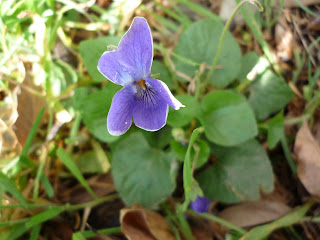


The beginning of spring is the time to harvest Birch sap, this winter was a long a particularly hard one here in France. I visited the birch wood a couple of times to find that there was no upward moving sap at all. Finally, three weeks later than last year the sap flowed. I had left a bottle ready hanging on one of the birch trees the last time I had visited the forest, so when Romain and I arrived we were greeted by a full bottle of birch sap. What a pleasure to drink this springtime offering from nature amongst the trees themselves.
In order to successfully tap the sap, there are surely many different methods but the one we use is as follows, drill a hole into the tree preferably with a small, hand drill, the hole should be a couple of cm's deep and directed slightly upwards (in order to help the flow of sap). If the sap is flowing, you will quickly notice some moisture forming, followed by drops of clear sap. Put a straw in the hole, tie a bottle around the tree with the straw inside and hey presto.....no in fact not hey presto as it takes some time to fill the bottle, I usually leave them for 24 hours but it can take slightly longer depending on the speed of the sap flow. Do not forget to fill the hole with a stick the right size when you have finished so that the tree doesn't loose all its sap for nothing.
I have read that all birch trees can be tapped and I have also read that certain have a bitter flavour, the birches we have here in our little forest are Betula pendula or silver birch and as I have not tried any others I cannot make the comparison. All I can say is that the Betula pendula produces a fresh, slightly sugary and very tasty sap .
Why tap birch trees in spring you may ask...... well the cleansing and strengthening properties are very useful after a long winter, flushing out built-up toxins and helping in cases of rheumatism, gout, skin diseases and urinary tract problems....not bad eh!
A small glassful the morning for 7 days is a great way to spring clean a clogged up metabolism.
Be careful because birch sap is not a product that keeps for long, keep it in the fridge and consume within 3 or 4 days. It freezes well but freezing will change its molecular structure, so there is the question of whether this change also changes its properties. I personally like to use it fresh from the tree as a once yearly ritual, I connect with nature, from the inside...thanks to these wonderful trees. The symbolism of regeneration linked to the birch is very ancient, the Germanic/Scandinavian rune Berkana or birch represents re-birth, surely linked to this magical substance that flows from the earth through the birch itself and brings new life in the form of the awakening of spring.















 Tiny bush growing on altiplano, Bolivia.
Tiny bush growing on altiplano, Bolivia.


